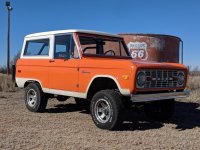73 Bronco with 1” body lift and 2.5 suspension lift. I need new tires and wanting to go a little taller. Current tires are 235/75/15. From other threads I’ve read I’m leaning toward 33/10.5/15. Any other suggestions?
I think a lot of members have done that size successfully. But keep in mind that some of that success was achieved through moving the rear axle back an inch or so.
In other words, they don't always just "fit" in the back without some additional work.
I know I will need to change my speedometer gear with the bigger tires, how do you figure the right gear?
I believe that there are now some good charts that will get you close. But assuming you have it back on the road with the new tires, you either use a GPS device of some kind (smart-phone app most likely?) or a pace vehicle with a known good speedometer to shadow you and compare speeds.
There might be some variation on accuracy if you let the pace car set the speed at 60mph and you see what your speedo is reading, OR you run your rig up to an indicated 60mph and then ask what the reading was on the other vehicles gauge.
Whatever the difference in percent, that's the change in size (smaller) you need with the new gear. Your speedometer will read slow with larger tires, and to compensate you need a smaller diameter gear on your cable. The "driven" gear.
If your speedometer reads 60mph when you are in fact traveling at 66mph, you're roughly 9-10% off. If you currently have a 21t gear, you would use a 19t gear to correct.
Of course, it's not always that simple. If you are already running with a 16t, or even a 17t gear, you can't go low enough to perfectly compensate since 16t is the smallest driven gear available for the stock setup.
At that point, you might be able to find a different drive-gear. There were two sizes commonly available for the Dana 20 transfer case. You will have to remove your speedo cable to see what driven gear you have, and may be able to count the teeth on the drive gear through the hole to see which one you have. Maybe...
If you have the smaller one, you could go to the larger one to bring the speed up some at the speedometer. If you already have the large one though, you're out of luck and would have to do something else to compensate.
Also, the outside of my front tires wear much faster than the inside, how can I adjust the camber on my wheels?
Assumed you meant to say "outside" above where I corrected in RED?
If not let us know, but if so, then it could be just camber, OR a combination of camber and toe-in.
But the standard specification of 1 to 2 degrees positive camber does usually lead to excessive wear on the outside of the tires. For some reason, especially the passenger side on our rigs. Maybe there's just more camber on the right, with the cross-camber settings?
Your '73 should have a Dana 44 front end. The two methods to adjust camber are either spindle shims (tapered rings sandwiched between spindle and knuckle) or ball-joint eccentric collars.
Both are available in different increments with 1.5° correction being the max for either.
You would do well to get a readout of your current settings (if you don't have one already?) before deciding what to do though. Getting it on an alignment rack and a full printout will let you know what's going to be needed.
And it's just good stuff to know anyway.
Paul












